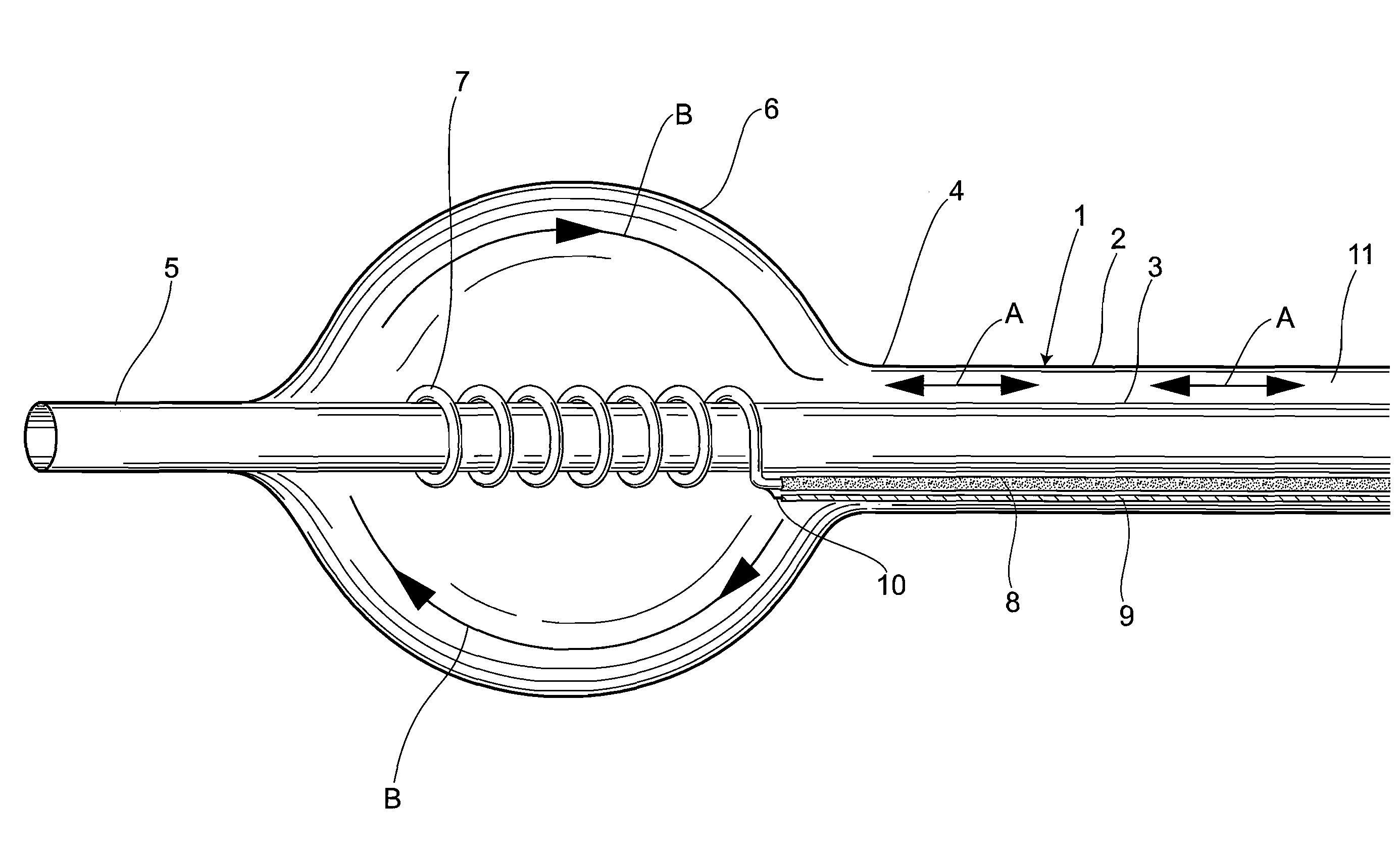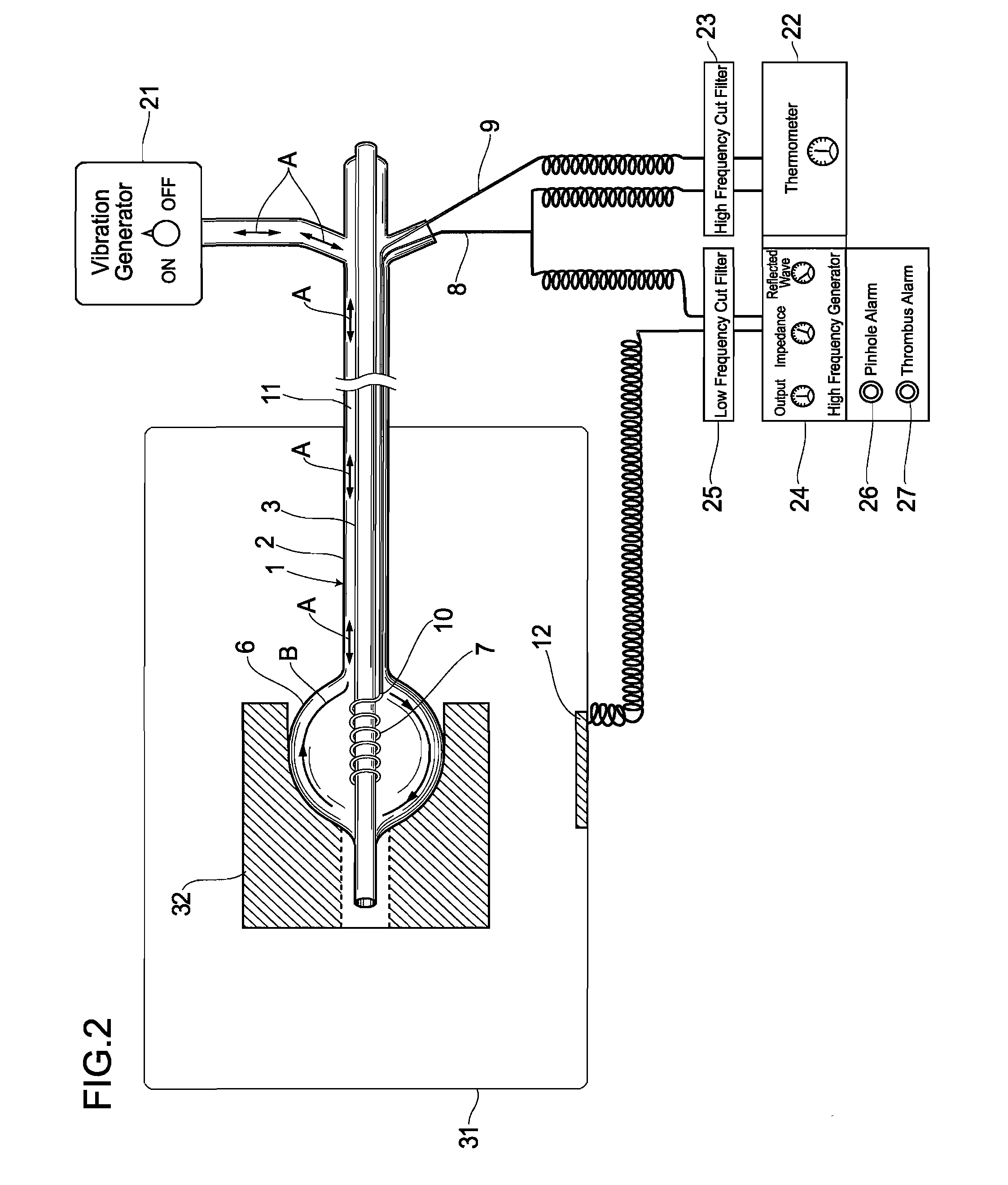Radiofrequency thermal balloon catheter system
a radiofrequency thermal balloon and catheter system technology, applied in the field of radiofrequency thermal balloon catheter system, can solve the problems of inability to detect pinhole phenomena in the balloon, inability to accurately and instantaneously detect pinhole phenomena, etc., to achieve efficient heating, accurate and instantaneous detection, and small heat capacity
- Summary
- Abstract
- Description
- Claims
- Application Information
AI Technical Summary
Benefits of technology
Problems solved by technology
Method used
Image
Examples
embodiment 1
[0026]The structure of the radiofrequency thermal balloon catheter system of the present embodiment is described, with reference to FIG. 1 and FIG. 2.
[0027]Reference symbol 1 denotes a catheter shaft. This catheter shaft 1 is composed of an outer tube 2 and an inner tube 3 which are slidable with each other. A balloon 6 is provided between a distal end 4 of the outer tube 2 and the vicinity of the distal end 5 of the inner tubes.
[0028]A coiled electrode 7 serving as a unipolar electrode for delivery of radiofrequency energy is provided inside of the balloon 6. Moreover, a radiofrequency transmission line 8 is connected to the coiled electrode 7. More specifically, the coiled electrode 7 is formed in a coil shape extending from the distal end of the radiofrequency transmission line 8, and is wound around the inner tube 7 inside of the balloon 6. In the present embodiment, the radiofrequency transmission line 8 is formed from a coated copper wire, and the coiled electrode 7 is formed ...
experimental example 1
[0054]The laboratory bath 31 was filled with a physiological salt solution at 37° C. to perform the experiment. The balloon was brought into contact with the phantom 32 in the physiological salt solution, and energized with a radiofrequency from the radiofrequency generator 24. Then, after about 100 seconds, the impedance, the output, the temperature of the center of the balloon 6, and the reflection waves were all in a steady-state. After 300 seconds from the start of energization, when a pinhole occurred in the balloon 6, although the output, the temperature, and the reflection waves slowly changed, the impedance was sensitively reacted and rapidly decreased.
experimental example 2
[0055]The laboratory bath 32 was filled with a heparinized whole blood solution at 37° C. to perform the experiment. The balloon was brought into contact with the phantom 32 in the whole blood, and energized with a radiofrequency from the radiofrequency generator 24, at a set temperature of 100° C. The temperature of the center of the balloon 6 was gradually increased, and when this exceeded 80° C. after about 300 seconds from the delivery of radiofrequency energy, a thrombus was formed on the surface of the balloon 6. Accompanying the thrombus formation, although the output, the temperature, and the reflection waves were slowly changed, the impedance was sensitively reacted and rapidly increased.
PUM
 Login to View More
Login to View More Abstract
Description
Claims
Application Information
 Login to View More
Login to View More - R&D
- Intellectual Property
- Life Sciences
- Materials
- Tech Scout
- Unparalleled Data Quality
- Higher Quality Content
- 60% Fewer Hallucinations
Browse by: Latest US Patents, China's latest patents, Technical Efficacy Thesaurus, Application Domain, Technology Topic, Popular Technical Reports.
© 2025 PatSnap. All rights reserved.Legal|Privacy policy|Modern Slavery Act Transparency Statement|Sitemap|About US| Contact US: help@patsnap.com



